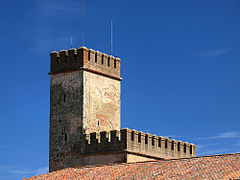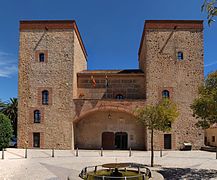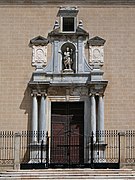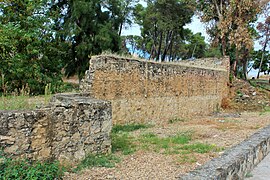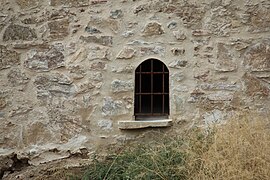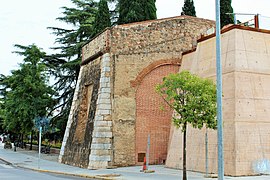
A | B | C | D | E | F | G | H | CH | I | J | K | L | M | N | O | P | Q | R | S | T | U | V | W | X | Y | Z | 0 | 1 | 2 | 3 | 4 | 5 | 6 | 7 | 8 | 9
This article may require copy editing for grammar, style, cohesion, tone, or spelling. (June 2023) |
| Badajoz bastioned enclosure | |
|---|---|
| Perimeter of old Badajoz in Spain | |
 "Plan of the siege that the rebel put on the city of Badajoz" (Planta del sitio que el revelde puso a la ciudad de Badajoz, sic) by Kungl Krigsarkivet in 1658. | |
| Coordinates | 38°52′55″N 6°58′08″W / 38.881914°N 6.968992°W |
| Type | Fortified and bastioned enclosure |
| Area | 6541 m of preserved wall (including the citadel-castle) |
| Site information | |
| Owner | Badajoz City Council |
| Condition | Restored; in very good condition |
| Site history | |
| Built | 17th to 18th century (prolonging an earlier defensive system from the 9th to the 16th century) |
| Built by | System of Sébastien Le Prestre, Marquis de Vauban or simply Vauban. |
| Materials | According to the different rehabilitation, masonry, dimension stone, brick and concrete |
| Bien de Interés Cultural as Conjunto histórico | |
The bastioned system of the Spanish city of Badajoz consists of a military fortification formed by a set of defensive walls, city gates, bridges, forts, towers, bastions, hornworks, moats, tunnels and ravelins, among other defensive elements. It was built between the 17th and 18th centuries, following the defensive construction theories popularized by the French military engineer Sébastien Le Prestre, better known as the Marquis de Vauban, as an extension of a previous defensive enclosure that protected this border town.[1]
Ever since Ibn Marwan founded Badajoz (over an earlier Visigothic settlement, since settlements in Badajoz date back to prehistoric times), the city had a stronghold character that was maintained until the 20th century. This is due to the privileged strategic location at a crossroads of two communication routes: one is the one from Castile to Andalusia, and the other from the plateau to Lisbon. In addition to being a border city with Portugal, this situation has been, on some occasions, a source of advantages for the development of Badajoz and on others, many more, a place of confrontation for various armies over the last few centuries. For these reasons, the city was protected by several defensive enclosures.[2]
The first fortifications were carried out by Ibn Marwan, who ordered the erection of mortar walls. This was followed by the restoration carried out by Abd Allah Ibn Muhammad Ibn Abd al-Rahman, grandson of the founder of Badajoz, in 913. Later, in 1030, it was rebuilt by Abdallah ibn Al-Aftas, the first Aftasid king of the Taifa of Badajoz. In 1169 the Alcazaba was built, very similar to the present one with some parts coming from the first period of the Almohad domination. The last Muslim restoration was ordered by Abu Yahya ibn Abi Sinan, when he was governor of the city at the beginning of the 13th century.[3]
After the confrontations that took place between Castile and Portugal during the 14th century, the relations between both were normalized in an atmosphere of peace that lasted almost two and a half centuries. But in 1640, when Portugal became independent from the Hispanic Monarchy, Badajoz became a border city and because of its geostrategic position, the Castilian authorities realized the need to improve its current defenses. It was then when the authorities of the Crown and Badajoz made the decision to carry them out. Among the various possibilities offered by the military engineers, it was decided to undertake the works following the system devised by Vauban. However, these works were not carried out in an orderly fashion, but rather it was improvisation, in the midst of a precarious economic situation. The reforms and improvements were successively made to the existing defenses.[4]
Background



The city of Badajoz, specifically the oldest area, located in the highest part of the promontory called Cerro de la Muela, was defended by the enclosure built in the Islamic period, whose fortress is known as the Alcazaba. The city of Badajoz in Islamic times was surrounded by a defensive wall that protected the al-qasbah –ksar–, the citadel, an administrative area and residence of the rulers of the Kingdom of Badajoz (one of the largest taifas of the Iberian Peninsula), where the Alcázar, the mosque and one of the largest libraries of the time were located, whose defensive wall had successive extensions. The buildings of its interior are a proof of the different functions that the enclosure had in the different epochs: Islamic citadel, with different extensions until it reached an extension similar to the so-called "Cerca Vieja", −9th–13th centuries–, Christian late medieval castle, highlighting the first Badajoz Cathedral built on the palatial mosque, as well as different "fortified houses" to ensure its defense −13th and 16th centuries–, and as part of the citadel and fortification of modern construction −17th and 19th centuries–, highlighting in them different religious buildings, as well as the different secret passage and cisterns reused at different times.[5]
The city continued to grow outside the walls, especially to the west and south because of the flatter areas, encircled by a medieval wall of rammed earth of probable Almohad origin, with later extensions, which was followed by a late medieval pentagonal fence, contemporary to the Catholic Monarchs, at the end of the 15th century, which connects with the Palmas Gate at the height of the Palmas Bridge and the Pajaritos Gate, both from the 16th century, inside which were inserted the neighborhoods that form the historic district and whose defenses were insufficient in the face of the progressive development of artillery during the next century.[6][7] From 1642, in the context of the war with Portugal, is when a series of isolated and improvised defensive constructions began, as was the fort of San Cristobal, on the right bank of the Guadiana River, north of the city, on an important promontory called Orinaza Hill. This construction was considered the first of its kind in terms of defensive fortifications. In addition, this fort protected the head of the bridge, on the same bank of the river, which was an extremely strategic element since the bridge was the natural entrance to Badajoz. To protect the bridge, a series of defensive works were carried out, such as the demolition of several arches and their replacement by a drawbridge with three spans and the construction of parapets where the garrison of this outpost could be defended.[8]
Shortly after, the Pardaleras fort was built at the opposite end of the city, that is, to the south of the city. Other defensive elements such as moats, walls, etc. were also added without following a certain order and were therefore not very effective. Nor were adequate materials used to cope with modern artillery which led to significant losses of land, buildings, etc. At the end of the 17th century, between 1690 and 1700, work began on the bastioned fortification. This new defensive wall started from the medieval wall, continued along the left bank of the Guadiana River to the bastions of San Vicente and Palmas Gate, turned west and then south through the bastions of San José, Santiago, Santa María and Trinidad Gate to finally connect with the defensive wall that protected the Alcazaba. Through the existing military cartography it is known that the watchtowers, from the Islamic period, were in use until the War of Independence, completing the defensive system (of the numerous watchtowers that Badajoz had in the past, fundamentally from the 12th century, only vestiges of five of them are conserved, standing out the Espantaperros Tower and the Tower of Los Rostros).[1]
- Gallery
-
Abarlongada Tower from the chemin de ronde of the city defensive wall
-
Hanged Men Tower
-
Albarrana Tower
-
Front view of the Espantaperros Tower
-
Interior of the Alcazaba
-
Exterior of the Alcazaba
-
Interior door of the Alcazaba
-
Defensive walls and chemin de ronde of the Alcazaba of Badajoz
-
Sapur tombstone
-
Capital Gate
-
Capital Gate (back)
-
Curved gate
-
Views of the Alcazaba and the town halls from Plaza Alta
-
Carriage Gate or Yelbes Gate
-
Alcazaba Access
-
Lintel door
-
Alcazaba of Badajoz wall
-
Palace of the 16th century (Provincial Archaeological Museum)
-
Remnants of the Mosque-Cathedral (next to the old Military Hospital)
-
Alcazaba parapet
-
View from inside the Alcazaba
History

Portugal and Castile maintained a series of confrontations in the 14th century. In the year 1580, Philip II moved the Court and the bulk of his army to Badajoz (being for eleven months his residence), annexing Portugal to the whole of the Hispanic Monarchy. The tensions for the city of Badajoz arose later, from 1640, given the proximity of the city to the border, as a consequence of the uprising of the Portuguese against the Crown of Castile.[9]
The bastioned enclosure began to be built in the 17th century, over a previous defensive system, when it was necessary to defend the square of Badajoz, seat of the General Captaincy of the Royal Army of Extremadura, due to the hostilities that led Spain and Portugal to the Portuguese Restoration War through which Portugal wanted to achieve its independence from Spain. Since then, Badajoz was consolidated as the capital of the Province of Extremadura and the most important border town among all those located near the border, which is why it was a place of great strategic interest for Spanish and Portuguese. The war lasted from 1640 to 1668, year in which by the Treaty of Lisbon, Spain recognized the complete independence of Portugal.[10]
Given its frontier character, the Badajoz Cathedral −13th–18th centuries– resembles a fortress: it has strong walls, battlements and a powerful tower where the bell tower is located. It was declared a Historic-Artistic Monument in 1931, as an Asset of Cultural Interest, being unique in its kind and time. The history of the Diocese and Bishopric of Badajoz dates back to the 10th century, currently holds the rank of Metropolitan Cathedral. Inside it houses an Islamic pottery of the 10th century and the Metropolitan Museum of the Cathedral. Nearby is the historical archive.[10]
The geographical features of the terrain on which the city of Badajoz sits conditioned since its foundation the consideration of a point of warlike and strategic interest and was a key point of the Spanish defensive system in the area since Portugal had its powerful defensive system of Elvas. For this reason Badajoz was the great stronghold of La Raya with Portugal. On the other hand, its geographical location in the Iberian Peninsula also made it a desirable place, since it is almost at the same latitude as Lisbon and almost equidistant from Madrid and Lisbon, although somewhat further away from Madrid and not too far from Oporto.[11][12]

- Gallery
-
Exterior of the Cathedral-Fortress of Badajoz
-
Cathedral Door
-
Window detail
-
Door of the cathedral crypt
-
Top of the dome of the Church of the Conception, next to the tower of the Cathedral
The onset of defenses


The bastioned enclosure was built on the foundations of the old medieval walled enclosure (9th to 15th centuries), which still existed until the 17th century; some sections were preserved, such as those next to the bastion of La Trinidad and the bastion of Santiago. The old medieval fence or "old fence" of the city (which prolonged the current citadel) had become outdated against the use of the artillery of the Portuguese army, mainly, since they had spent almost two and a half centuries of abandonment so it had aged to make it obsolete. In such a way it was so that the Count of Santiesteban wrote to the secretary Pedro Coloma about the defensive constructions in Badajoz, in which he commented that in Extremadura at that time −1643– there was no secure place in terms of defenses, provisions, artillery and other weapons. Only Badajoz seemed to have the minimum defensive conditions but the existing walled enclosure was totally ineffective. Only the upper part occupied by the alcazaba could have certain appropriate conditions and, therefore, the works of the new defensive walls should begin in that area.[13][14]
On the other hand, the Marquis of Torralbo wrote to the king in the following terms:
The inhabited enclosure of the Alcazaba encircled by the Almohad wall was with the fallen parapets and destroyed the faussebraye, as well as the doors, without closing or rake.
And he concluded by saying that it was within the reach of artillery, for which the rammed earth walls were absolutely ineffective:
... for it is within musket range from the fort of San Cristobal.[15][14]
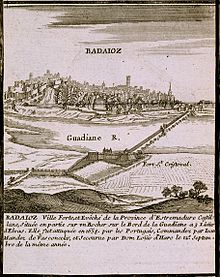
Gradually this defensive wall was replaced by a new one that started from the Muslim citadel, followed the course of the Guadiana River along its left bank and made a turn to the west and south where the bastions of San Vicente and Palma Gate were built. The construction continued to the west, south and east, areas where the bastions of San José, Santiago, San Roque, Santa María and Trinidad were built, successively, until linking up again to the northeast with the old alcazaba by means of the bastion of San Pedro.[10]
All the defensive elements that were built were adapted to the new trends in military engineering: lower and wider walls, to resist cannon fire and the introduction of bastions of large surface area, curtain wall flanks of the defensive wall that were buttressed instead of vertical to bounce the cannonballs upwards, half bastions that guarded the access gates, bartizan at the vertices of conjunction of two curtain wall of the defensive walls, moats in front of the defensive walls, lunettes and ravelins, etc. to hinder the action of the enemy. In spite of the serious and strong defensive structure, the defensive walls were decorated with a semicircular stone wall whose curved part was offered to the outside.[11]
The defensive system adopted was the one designed in his day by the French military engineer Sebastian Le Prestre, better known as Marquis de Vauban or simply Vauban.[16]
Elements

The bastioned enclosure is composed of several defensive buildings such as the curtain wall of the defensive walls, the gates, designed to allow and control the entry and exit of the inhabitants, the bastions consisting of pentagonal constructions, which joins two consecutive lines of defensive wall on the inner side of the pentagon, the forts located on the outside of the defensive walls and that were the first line of defense of the population and the ravelins that are triangular fortifications located in front of the body of the main fortification –generally on the other side of a moat– whose objective is to divide an attacking force and to protect the curtain wall of the defensive walls by means of crossfire. There are also other defensive elements such as moats, foothills, drawbridges, escarpments, etc. and some smaller buildings attached to or free of the enclosure.[10]
Bastions

A bastion or bulwark is a fortified redoubt that projects outward from the main body of a fortress, generally located at the corners of the curtain walls, as a strong point of defense against the enemy. It may have openings in its walls such as arrowslits, embrasures, etc. In bastioned fortresses they usually have a polygonal plan and low height to offer the smallest possible impact surface to the cannon projectiles and slightly inclined so that they do not impact frontally and bounce upwards. They usually have a moat in front and also foothills to increase their defensive power.[17]
There are different names to define each of the bastions according to the type and form of construction, such as "pincer bastion", "cut bastion", "orillon bastion", "prominent bastion", "double bastion", "irregular bastion", "full bastion", "regular bastion", "simple bastion", "empty bastion", etc.[18]
Semi-bastion of San Antonio


It is number 1 on the Plan of bastions. This semi-bastion joined the primitive alcazaba by its eastern zone with the rest of the bastioned enclosure. For its construction the old Alpendiz Gate was closed. To fill it with earth and stones on the inside so that it could withstand the impacts of the modern artillery, the materials of the Torre Vieja (Old Tower) were used, so it was left bareheaded. It was a tower that was part of a fortified enclosure with which it is communicated, although generally exempt from the defensive wall. What was left of the Old Tower was hidden due to this enclosure and to the fact that it remained inside the bastion. To replace the Alpendiz Gate a small door was opened as a gateway.[19]
It was built in the neighborhood of San Salvador and nowadays it is next to a modern park. When the Torre Vieja (Old Tower) was removed, it was buried, but in excavations carried out at the end of the 20th century, a large part of it was discovered.
A tour of the exterior from the southern part of this bastion to the junction with the defensive wall of the Alcazaba facing east.
- Gallery
-
Southern curtain wall with a mark of artillery bullet impact
-
Southern curtain wall with marks of artillery bullet impacts
-
Southern curtain wall very elevated on rock
-
Old defensive walls outside the bastion on the east side
-
Outer wall, of lesser size
-
Curtain wall of the bastion, old defensive walls and, in the middle, the moat
-
Eastern curtain wall and, in the corner, another one to the north. In the background another to the east
-
Moat between the bastion and the old defensive wall
-
Northern curtain wall elevated on rock. In the background the Espantaperros Tower
-
Three curtain wall of the bastion next to the junction with those of La Alcazaba
-
High area of the bastion with embrasures in the upper part
-
Coat of arms over the Merida Gate
-
Open gate when the Alpendiz Gate was closed
-
Entronque of the bastion with the defensive wall of La Alcazaba
-
Diagram of the Old Tower hidden by the bastion with upper embrasures
-
View of the interior of the bastion from its highest point
-
View towards Merida from the upper part of the bastion and embrasures
-
North and east curtain wall of the junction with La Alcazaba
Bastion of San Pedro




It has the number 2 in the Plan of bastions. It is located next to the "Semi-bastion of San Antonio" and before the one of Trinidad, in the eastern zone of the bastioned enclosure, in front of the Rivillas river. Between these two bastions is the Merida Gate. Its construction dates from the last decades of the 17th century, the same period as that of the bastion of Trinidad, making both the oldest bastions in the enclosure.[16] It had a series of bartizan of which only their bases remain, as well as embrasures at the top of the defensive wall, but at present there are no remains of them. In 1772 the right flank of the bastion was provided with a series of arrowslits connected by a gallery for the circulation of the riflemen. The interior zone is very deteriorated.[20]
This bastion was of great importance during the War of the Spanish Succession since Badajoz suffered several sieges at that time; the most important was in 1705 when the supporters of Archduke Charles of Austria laid siege to Badajoz, which was defended by French and Spanish troops who remained loyal to Philip of Anjou. To take the city, the attackers established their artillery batteries on the other side of the Rivillas stream, at the height of "La Picuriña" and next to the hermitage of San Roque.[21]
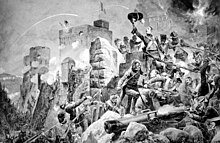
Their intentions were to attack the city by the weakest defensive side and open a breach in the defensive wall that allowed them to penetrate it, for which they focused the shots on the bastion of San Pedro and managed to open a breach but the arrival of French reinforcements dissuaded them from entering the assault. The experience gained from this conflict led the commanders of the troops of Badajoz to reinforce the defenses of this area and built a ravelin, which they called the ravelin of San Roque, and a fort outside the defensive walls that was called the fort of the Prince and later renamed the fort of the Picuriña.[21] The redcoats of the future Duke of Wellington, commanded by the General of the 3rd Division Thomas Picton, entered this area in 1812 after the third assault for the liberation of Badajoz, which resulted in a large number of casualties. As a reminder of this combat, the soldiers marked the date "1812" on one of the curtain wall of this bastion by tearing out the corresponding stones so that the date could be seen. Still visible in its corners are the impacts of the cannonballs of the War of Independence.[22]
- Gallery
-
Beginning of the bastion in its northeast zone
-
Several walls on the east flank
-
Zdroj:https://en.wikipedia.org?pojem=Badajoz_bastioned_enclosure
Text je dostupný za podmienok Creative Commons Attribution/Share-Alike License 3.0 Unported; prípadne za ďalších podmienok. Podrobnejšie informácie nájdete na stránke Podmienky použitia.
Antropológia
Aplikované vedy
Bibliometria
Dejiny vedy
Encyklopédie
Filozofia vedy
Forenzné vedy
Humanitné vedy
Knižničná veda
Kryogenika
Kryptológia
Kulturológia
Literárna veda
Medzidisciplinárne oblasti
Metódy kvantitatívnej analýzy
Metavedy
Metodika
Text je dostupný za podmienok Creative
Commons Attribution/Share-Alike License 3.0 Unported; prípadne za ďalších
podmienok.
Podrobnejšie informácie nájdete na stránke Podmienky
použitia.
www.astronomia.sk | www.biologia.sk | www.botanika.sk | www.dejiny.sk | www.economy.sk | www.elektrotechnika.sk | www.estetika.sk | www.farmakologia.sk | www.filozofia.sk | Fyzika | www.futurologia.sk | www.genetika.sk | www.chemia.sk | www.lingvistika.sk | www.politologia.sk | www.psychologia.sk | www.sexuologia.sk | www.sociologia.sk | www.veda.sk I www.zoologia.sk



